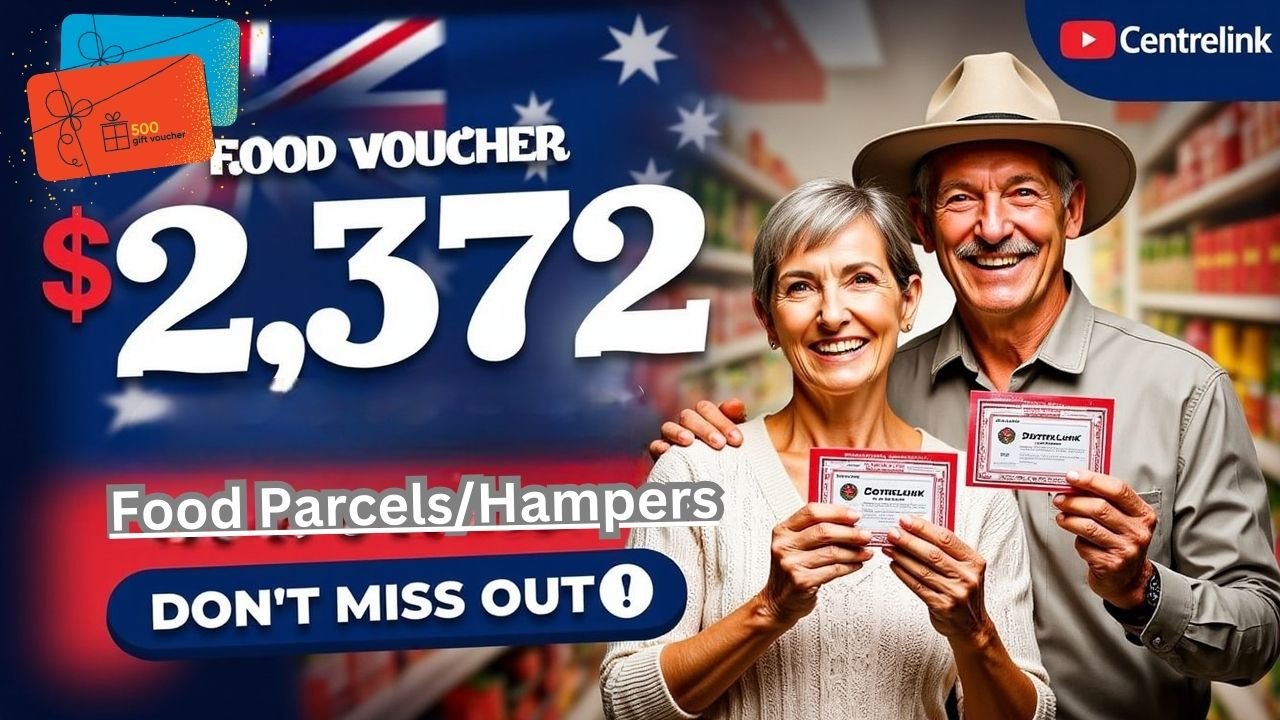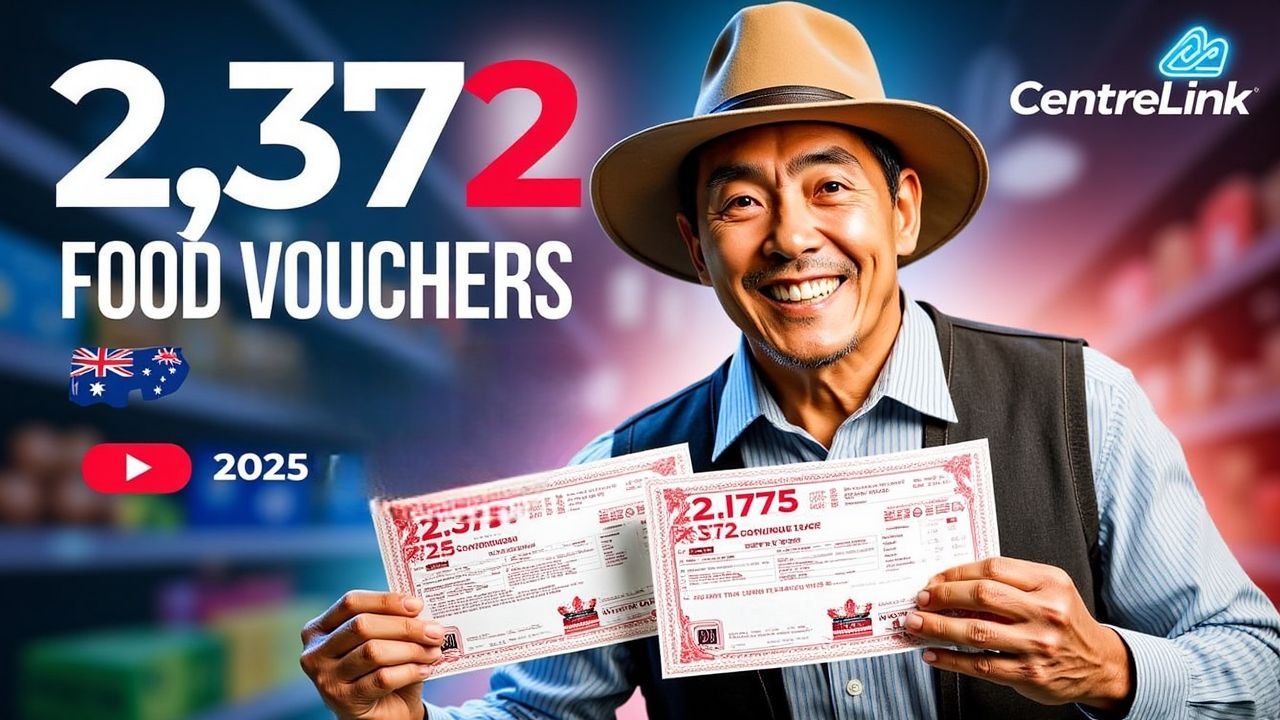The ever-increasing cost of living is still striking into the Australian households in 2025.
For most families, nutritious food has become increasingly unaffordable.
Through Services Australia, Centrelink provides various aids for people in financial hardship.
This is a complete guide to food vouchers, emergency relief and other supports available for eligible Australians.
Emergency Relief Programs:
Your Lifeline When You Need It Most
- When uninvited financial troubles come knocking, emergency relief programs invariably step in to give some assistance at such short notice.
- These programs can provide support through food parcels, vouchers, and on some occasions even cash for essential needs.
- Services Australia doesn’t itself issue food vouchers but partners with community organizations that do provide such essential services.
- Community organizations include the Salvation Army, St Vincent de Paul Society, and other local charities throughout Australia.
- These organizations look into each situation on its merits and extend proper assistance according to the circumstances of the case.
Who Gets Access to Food Vouchers and Emergency Relief?
Food assistance programs have been established aid that can help people on real financial troubles.
You are likely to be qualified if you:
- Are on Centrelink payment or low income
- Have faced Unexpected financial hardships
- Struggling to obtain basic necessities
- Have Children or dependents to look after
- Are homeless or might become homeless
- Escaping from domestic Violence
- Recently suffered a natural disaster
All have different criterions of assessment, but most are for immediate need.
Many Centrelink recipients tend to qualify because their financial position can be dire, but it is not essential that you be one to qualify for emergency food assistance.
Types of Assistance Available for Food
- Food Vouchers
- Food vouchers are issued by community groups, and the usual area of usage is in the bigger stores.
Such vouchers ensure that families can buy food and necessary groceries when in dire straits.
The value of vouchers can also change on the basis of circumstances, size of family, and organization providing assistance.
Food vouchers may include restrictions on what may be purchased, so essential items may be okay, but alcohol and tobacco are generally not.
Food Parcels/Hampers
Many charities will provide prepackaged food parcels containing necessary items.
Parcels usually comprise non-perishable foods such as pasta, rice, canned goods, and usually some fresh produce when stocks are available.
Food parcels can stand in as a temporary relief during struggles when you’re unable to put meals on the table.

Shared Meals
Community kitchens offer free or inexpensive meals in several towns around Australia.
These programs are not just source of nutrition but also provide meal fellowship to some who may be isolated or vulnerable.
Many local centers, churches, and community organizations have open meals at regular intervals for all those who see an opportunity.
Top-down Access to Food for 2025
Post not found.
Step 1: Contact Services Australia
To begin with, Services Australia can be contacted through the myGov account, visiting a service center, or alternatively calling the emergency assistance line.
They would inform you about nearby emergency relief providers and in some deserving cases, may provide a one-off Crisis Payment.
The staff will be able to map suitable services to your location and needs.
You should discuss your financial situation with them quite frankly so that they will inform you of any options for assistance that may best fit your situation.
Step 2: Connecting with Local Emergency Relief Providers
Usually Services Australia would refer you to a local organization to give you relief.
Such organizations could be:
- Salvation Army
- St Vincent de Paul Society
- Red Cross
- Local community centers
- Religious organizations and charities
- Food banks
Those organizations’ contact information will be given to you by Centrelink, or you could search for emergency relief online in your area.
The assessment usually gets arranged after you contact a relief organization party.
Step 3: Assessment Process
Depending on the organization’s requirements and your situation, the assessment can take place with the assessment personnel visiting you and others, doing it via telephone or video conferencing.
During the assessment process, the organization usually makes inquiries about your financial situation, such as any Centrelink payment you receive, what expenses you have, and what specific circumstances cause you to call for assistance at this time.
You will then be expected to produce an ID and demonstrate the financial hardship, for example, through bills, bank statements, or rental agreements.
Step 4: Receiving Assistance
After assessment, the agency will inform you what assistance they can mobilize.
This type of assistance may include food vouchers, prepaid cards, food parcels, or possibly another agency that may assist you with your problem.
Remember, emergency relief is intended to meet immediate, short-term needs rather than ongoing support. But should the nature of your situation require it, the organization may be able to refer you to longer-term programs.
Emergency food assistance may help in a crisis, while longer-term intervention may be required if one is experiencing ongoing financial difficulty.
Centrelink Payment Reviews
If one cannot make ends meet on the current Centrelink payment, one might ask for a review of one’s entitlements.
These might include additional supplements or another payment that better fits the person’s circumstances.
The Financial Information Service (FIS) run by Services Australia may give free, confidential advice about your personal financial situation.
Loans are provided for the purchase of basic necessities; the amounts will range up to $1,500, and no interest or fees apply.
Since these loans can be utilized for other expenditures, they will have the knock-on effect of leasing expenditures and groceries.

Rental assistance
Housing costs sometimes take out a very large chunk of the household budget.
Eligible tenants can benefit from the extra help Rent Assistance oxygenates to relieve housing stress and to be used on food and other necessities.
Advance payments
If you receive certain payments, you may be able to get an advance on some of your later payments to cover these expenses.
This does not, however, increase the actual payment amount; it merely aids you in reining in short-term cash flow hurdles.
Special Food Aid Programs: Uniquely Attuned to the Groups
Families with Children – Families with children can avail more from Centrelink services.
The Family Tax Benefit helps families and raises their support for raising children, while the parenting payments provide income support to primary caregivers for children of this age.
Although indirect in directly assisting food costs, these benefits often enhance the overall income from which food costs may also be subsumed.
Moreover, some social organizations provide lunch programs in schools and holiday meal distributions to supplement other food supplies for families with children.
Seniors
Older Australians experiencing food insecurity may be eligible for certain types of assistance.
Meals on Wheels delivers meals regularly to seniors who find difficulty in preparing it for themselves.
In addition, several community organizations provide food parcels for seniors or meal services with specific nutritional requirements for older adults.
Persons with Disabilities
Food access problems may become compounded for those with disabilities.
Number of NDIS participants may include meal preparation assistance in their plans, by reason of inability to shop or prepare food independently.
Many community programs in food supply also assist in delivering food to consumers who simply cannot move much.
Rural and Remote Communities
Most Australians living in rural and remote areas will undergo some special considerations for accessing cheap food.
More specialized outreach programs are known to operate in certain remote areas to assist this demographic in accessing emergency relief and food assistance.
Such help could involve mobile food vans, community transport to food relief centers, or subsidized delivery services.
- Food Resources Optimization Tips
- Supermarket Budgeting
- Stretching your food budget requires planning ahead and shopping wisely.
This is what can help:
- Plan meals around seasonal produce and sale items
- Purchase staple items in bulk only if they are on special sale
- Maximize a supermarket loyalty program for discounts
- Always compare unit prices, not package prices
- Look out for house brands for better pricing
If you start grocery shopping late in the day, odds are better you might grab fresh items on clearance
Many organizations in your community provide free cooking classes in budget cooking and resources to help maximize your food budget.
Community Gardens and Food Cooperatives
In many communities, some gardens or food cooperatives have been established to provide fresh produce at affordable prices.
Joining these initiatives is a good way to decrease food costs while building a community and learning constraining skills.
Some community gardens have set aside some plots for people experiencing food insecurity, while some give away part of their harvest to local food relief programs.
Reducing Food Waste
Food rescue organizations such as Oz Harvest and Second Bite take good quality surplus food and distribute it to needy people.
Many community organizations combine efforts with these services to assist in providing fresh food that otherwise might have gone to waste.
Also, learning how to preserve food by freezing, canning, or dehydrating will stretch your food resources and create minimum waste in the home.
Advocating for Your Needs
When you’re trying to get the support you need and trying to fight to make ends meet, don’t hesitate to advocate for yourself.
Social workers within community organizations can sometimes show you the way and make appropriate referrals for you.
They are there to help you, so just tell them what the help is that you need.
The reason behind honesty is they will be able to consider your narrative as it relates to the services they would offer.
Building Food Security for All Australians
Food security remains a major challenge for many Australians as of 2025; however there is a range of support systems in place for those qualifying.
This way, you have support to help you through the hard times by knowing what is available and how to access them.
Remember, it is not a fall that you have put your hand up to receive help-the biggest step will always be towards stability and well-being for yourself and family.
If you are able, consider donating to local food-relief organizations or even volunteering.
Strong safety nets developed which include everyone and make up for truly resilient societies.
Please refer to the Services Australia site or else contact the local service center to stay updated on the latest news on Centrelink or emergency relief, now, finally.
FAQS:
Are food vouchers available to Centrelink recipients?
Yes, food vouchers may still be granted to Centrelink beneficiaries, especially during emergencies or financial distress.
Are food vouchers accessible in all states in Australia?
Yes, food vouchers and emergency relief programs are available in all states of the country; however, specific eligibility requirements and benefits may differ according to the state or territory.

